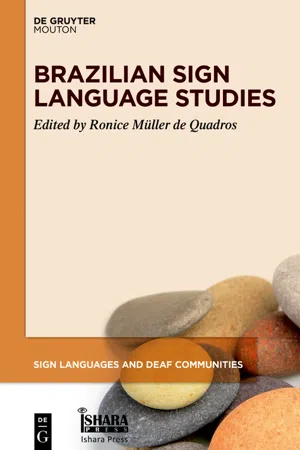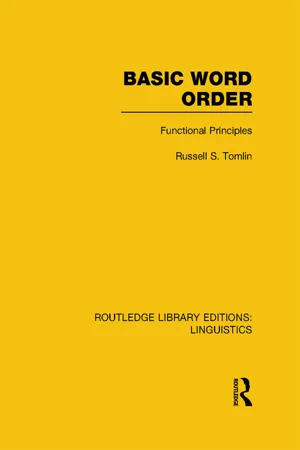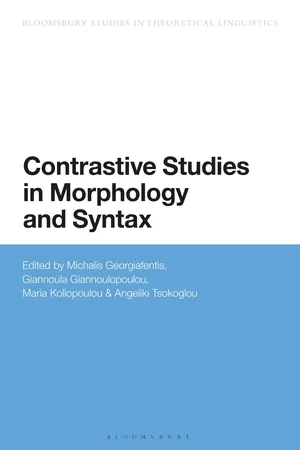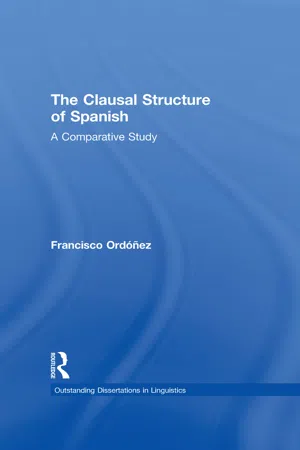Languages & Linguistics
Verb Subject Object
"Verb Subject Object" is a basic sentence structure found in many languages, where the verb is the action or state, the subject is the doer of the action, and the object is the receiver of the action. This structure is commonly used in English and other Indo-European languages, but not all languages follow this specific order.
Written by Perlego with AI-assistance
Related key terms
5 Key excerpts on "Verb Subject Object"
- eBook - ePub
- Ronice Müller de Quadros(Author)
- 2020(Publication Date)
- De Gruyter Mouton(Publisher)
Moreover, Felipe (1989) and Ferreira-Brito (1995) claimed that even though there is certain flexibility, there seems to be a predominant order, to wit: SVO. We are going to support their intuition by presenting some sentences with adverbs, modals, negation and subordination; and by discussing their respective word orders. Most of the data is from Quadros (1999) and we also adopt the theoretical analysis proposed there, with a few adaptations. First of all, we have to find out what the possible word orders are in Libras. According to Greenberg’s (1996) typology, languages may exhibit six different orders: SVO, SOV, OSV, VOS, OVS and VSO. Quadros (1999) provides examples of SVO, SOV and OSV sentences. Arrotéia (2003) shows a specific context in which VOS order emerges in Libras. No OVS and VSO sentences have been documented in the language so far. 2.1 Underlying order of verb, subject and object In order to identify which is the underlying word order, we have to look at the contexts in which each of the possibilities emerges, and also the restrictions. To start the analysis, let us compare three different transitive sentences and how they behave in different orders. The first sentence contains a plain verb (no morphological agreement) and arguments that are semantically distinct. The second sentence contains the same verb but the arguments have the same semantic features, so they can be considered reversible arguments (both can be the subject or the object of the sentence). Finally, we analyze a sentence with a non-plain verb, which is a verb that shows morphological agreement - eBook - ePub
Basic Word Order (RLE Linguistics B: Grammar)
Functional Principles
- Russell S Tomlin(Author)
- 2014(Publication Date)
- Routledge(Publisher)
In SVO and SOV languages, placement of modals that would separate the object from the verb are forbidden. English can be used to illustrate the general pattern: Steele catalogues a substantial number of SVO languages that follow this pattern: Modal placement in SOV languages tends also to be consistent with VOB:However, in VSO languages, modal elements may sometimes, as in (82), separate the object from the verb. But if modal elements do separate the object from the verb in some language, they also separate the subject and verb:Steele provides no data concerning VOS languages, but in Toba Batak modals precede the verb obligatorily:Finally, Steele’s analysis of Thai is not complete. While most modals in Thai do precede the verb, there are several which may follow it. However, these modal elements must follow the entire VO complex. Thus, the one example that varies from the general patterns Steele observes varies from those patterns in a manner totally consistent with VOB.Proverbal ReplacementsIt is possible in some languages to replace a verb+object phrase by a proverbal form. In no case has it been observed that a proverbal form can replace a subject+verb phrase in a transitive clause. If there were no special syntactic relationship between object and verb, there should be an equal possibility of observing either verb-object or verb-subject proverbal replacements. The data reveal, however, that there is not an equal possibility for each type of proverbal replacement. Therefore, some special relationship must exist between verb and object. The VOB principle states what the relationship is.Illustrative data for proverbal replacement comes from English: Movement ConstraintsThe data presented in this section demonstrate the cohesiveness of verb and object (as opposed to verb and subject) with respect to their sensitivity to movement rules. In the case below there is a movement rule sensitive to the bond between object and verb, but no parallel evidence of any such sensitivity to a verb-subject relationship. As in the cases above, this behavior can be explained by the VOB principle. - David Hornsby(Author)
- 2014(Publication Date)
- Teach Yourself(Publisher)
do-support.Spotlight: Flexible word order: LatinConstituent order plays a more important role in determining argument structure in English than in many other languages. In Latin, for example, a rich system of case marking on nouns allowed for much freer order of subject and object NPs and VPs. The default or unmarked word order was subject–object–verb (SOV), but other orders, conveying the same information but with slightly different emphasis, were also possible.In the examples below, the subject lupus (‘wolf’) is marked as nominative (subject), and the object gallinam (‘hen’) is marked as accusative (direct object), which allows the simple sentence ‘The wolf sees the hen’ to be expressed in six different orders:1 Lupus gallinam videt. (SOV)2 Gallinam lupus videt. (OSV)3 Videt lupus gallinam. (VSO)4 Videt gallinam lupus. (VOS)5 Gallinam videt lupus. (OVS)6 Lupus videt gallinam. (SVO)Government and agreementAs we have seen, sentences are both ordered and hierarchically structured. In many languages, the relationships between elements within a phrase or sentence are formally marked. In English, for example, the form of the demonstrative adjectives this and that must agree with its noun for number:• This dog• These dogs• That house• Those housesThis marking of relationships is known as agreement or concord, and often affects items at some distance from each other in a sentence. In the following example, the third person singular form requests is required to mark agreement with the head of the complex subject noun phrase (boy):• The boy with the long unwashed hair whom you met at a party last Friday requests the pleasure of your daughter’s company.Formal agreement marking in modern English is relatively limited: verbs, with the exception of to be- eBook - ePub
- Michalis Georgiafentis, Giannoula Giannoulopoulou, Maria Koliopoulou, Angeliki Tsokoglou(Authors)
- 2020(Publication Date)
- Bloomsbury Academic(Publisher)
It is well known that subject inversion is more productive in Spanish than in Italian (Lobo and Martins 2017 ; Leonetti 2017). This is essentially due to the constraints that Italian places on inversion with transitive verbs. On the one hand, VOS is mostly used in Italian with narrow focus – possibly contrastive – on the final subject, whereas it can also be used with wide focus readings in Spanish – though narrow focus on the subject remains the preferred interpretation. On the other hand, the VSO pattern is usually excluded in Italian, as it is in French and Catalan, but is quite common in Spanish, European Portuguese and Romanian (Leonetti 2014b). In VSO order, the subject must be focal, but it does not receive a narrow focus interpretation (unless the object is right-dislocated; we consider only Spanish sequences with no intonational breaks, i.e. without dislocations): VSO is associated to an interpretation that lacks informational Focus/background articulation, typically a wide focus reading. Significant differences between Spanish and Italian show up when the postverbal subject pronoun is within the focal domain without being a narrow focus. The VSO pattern is usually acceptable in Spanish, but not in Italian, as shown in the contrasts in (11)–(13). The presence of overt subject pronouns in Spanish VSO raises an interesting question: why do they appear there? They may well contribute to solving possible ambiguities in some cases, when verbal inflection is not explicit enough (Fernández Soriano 1999 : §19.3.6), and may also give rise to mild emphatic and contrastive effects in other cases (Fernández Soriano 1999 : §19.3.7), but such factors cannot definitely explain all uses, because in many examples the pronoun is neither emphatic nor contrastive (for instance, in (11)a and (13)a) - eBook - ePub
The Clausal Structure of Spanish
A Comparative Study
- Francisco Ordonez(Author)
- 2018(Publication Date)
- Routledge(Publisher)
In this chapter I have shown certain asymmetries between objects and subjects in the orders V O S and V S O in Spanish. The asymmetries in quantifier binding and Principle C between the two orders were explained by having the hierarchical relation between subjects and objects reversed, implying that objects C-command subjects only in the V O S order. This relation could only be obtained by moving the O to the left to some higher inflectional projection and having the subject in a lower position. The ban on wh-objects in situ in the V O S order was reduced to a ban on scrambling wh-in situ. The obligatory specific interpretation of the indefinite object in V O S order was seen as a consequence of the effects of scrambling on indefinites. The restriction of subject pronouns to the V S O order was explained by their semi-clitic nature which forces them to scramble to the left. Finally, the impossibility of having an empty counterpart of the dative clitic in the V IO S order was reduced to the fact that the conditions for licensing this empty category are not met in the landing site for scrambled XPs . In evcry case support for a scrambling account is found.This conclusion implies that the altemation S O and O S found in verb final languages like Korean, Hindi and German needs to be extended to languages where this alternation is obtained post-verbally such as Spanish. In principle, there is little reason why the same basic altemation should have two different analyses in UG (scrambling of the object to the left in verb final languages and adjunction of the subject to the right in nonverb final languages). The introduction of functional projections in the syntactic trees (Pollock 1989) and the hypothesis of verb movement (Emonds 1978), made scrambling a plausible analysis for nonverb final languages. It can therefore provide this uniform account. From the particular perspective of Spanish, it has also been shown that this analysis is empirically superior to the alternative Right Adjunction Hypothesis.Finally, our analysis, contrary to the free inversion hypothesis, conforms with and supports the line of research put forward by Kayne (1994), which derives linear order from hierarchical structure. This is done by what he calls the “Linear Correspondence Axiom” (LCA) which maps asymmetric C-command into linear precedence. Since the mapping is done into linear precedence, no right-adjunction is generated in syntactic trees.
Index pages curate the most relevant extracts from our library of academic textbooks. They’ve been created using an in-house natural language model (NLM), each adding context and meaning to key research topics.




